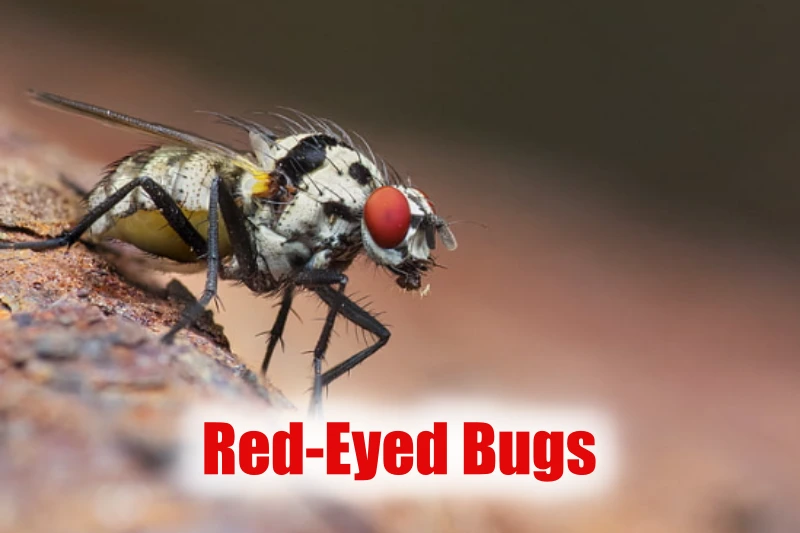The most common color eyes we have ever seen are black and brown in animals and bugs, even in humans, but there are so many animals, like cats and dogs, who have blue, green, and even yellow eyes.
But did you see any creatures with red eyes? It is mostly seen among bugs and creepy insects. Have you ever noticed red-eyed bugs? If not, here are some of the bugs with red eyes you might see but didn’t notice.
12 Red-Eyed Bugs
1. Red-eyed damselfly
| Scientific name | Erythromma najas |
| Size | Approx. 35 mm |
| Identification | Blue-colored abdomen |
First on the list is Red-Eyed Damselfly. As its name suggests, this species of damselfly has red eyes. They seem more attractive because of their blue-colored abdomen.
Usually, it has been observed that females have brown-red eyes and a dark abdomen.
The maximum length of these red-eyed bugs are 35 mm. Moreover, you can differentiate females from males on the basis of short yellow ante humeral stripes on the back of the thorax.
2. Red-eyed cicada
| Scientific name | Psaltoda moerens |
| Size | 110-120 mm |
| Identification | shiny black body |
Psaltoda moerens, also known as the red eye, is an Australian cicada species found in the southeast of Australia, from southern Queensland to South Australia and Tasmania. Its population can vary greatly between years, with large numbers appearing once and absent the next.
These red-eye bugs feed on eucalyptus and Angophora trees, expelling small droplets of clear waste fluid. The wingspan is around 110–120 mm, and the adult is shiny black above and brown and finely hairy underneath.
The red eye’s call consists of two to twelve revving sounds with a yodeling quality, followed by a rattling continuous call, made by flexing its abdomen upwards.
3. Fruit fly
| Scientific name | Drosophila melanogaster |
| Size | Approx. 2.5 mm |
| Identification | Black patch on the abdomen |
Drosophila melanogaster is a species of fly in the Drosophilidae family, known for its yellow-brown color, brick-red eyes, and transverse black rings across the abdomen. The name “melanogaster” comes from the black portions of the abdomen.
The fly’s eyes are brick-red due to two pigments: xanthommatin and drosopterins. It exhibits sexual dimorphism, with females being 2.5 mm long and males being slightly smaller with darker backs.
Males are easily distinguished by a distinct black patch on the abdomen and dark bristles on the sex combs. They also have a cluster of spiky hairs surrounding reproducing parts.
4. Pharaoh cicada
| Scientific name | Magicicada septendecim |
| Size | ~40 mm |
| Identification | Wings veins are red in color |
Magicicada septendecim, also known as the Pharaoh cicada or 17-year locust, is a 17-year periodical cicada native to Canada and the US. Its distinctive features include reddish eyes, wing veins, black dorsal thorax, broad orange stripes on its abdomen, and a unique high-pitched song resembling “weeeee-whoa” or “Pharaoh.”
5. Red-eyed bumble bee
| Scientific name | Centris rhodopus |
| Size | Approx. 25 mm |
| Identification | Red legs covered with black hairs |
Last but not least, we have a red-eyed bumble bee. The bee has a yellow-to-dark body color. The eyes of the bee are a deep red color.
The upper part of the bee is covered with yellow-colored hairs, while the red legs of the bee are covered with black hairs. Other than that, the whole oby is a dark tan or black color.
6. Golden-browed Resin Bee
| Scientific name | Megachile aurifrons |
| Size | 10-12 mm |
| Identification | greyish or white hairs |
Megachile aurifrons is also known as the Golden-browed Resin Bee and is an Australian native bee. They prepare nesting holes in disused mud wasp nests and collect pollen on their abdomen, storing it for offspring.
The golden-browed resin bee is larger than usual, measuring 10–12 mm in length. Both males and females have distinctive red eyes, and their common name “Golden-browed Resin Bee” is due to the resin they use to cap their nesting holes.
7. Brazilian red-eyed fly
| Scientific name | Ormia depleta |
| Size | 12-13 mm |
| Identification | Light tan or orange body color |
The Brazilian red-eyed fly, also known as Ormia depleta, is a small tachinid fly. This fly is recorded to grow, measuring 12–13 mm in size. Taking into account its coloration, this fly has a light tan or orange body color, and its eyes are red.
This red-eyed bug species got the shape of its body after passing through various stages, such as larvae and pupae. You can see that the larva has brown, cream-colored stripes, while the pupae are darker and larger.
8. Small red-eyed damselfly
| Scientific name | Erythromma viridulum |
| Size | Approx. 20 mm |
| Identification | Pale brown pterostigmata |
The small red-eyed damselfly, a member of the Coenagrionidae family, is a small damselfly with a black body and iridescent blue markings. Its large, spaced eyes are deep red, and both sexes have pale brown pterostigmata.
The male has a bronze-black top and blue sides, while the female’s thorax can be yellow, green, or blue. The rear edge of the pronotum is rounded.
The second and eighth segments of the male’s abdomen are mostly blue, distinguishing it from the red-eyed damselfly.
9. Flesh fly
| Scientific name | Sarcophaga |
| Size | 10-12 mm |
| Identification | Darker stripes on the thorax |
Sarcophaga is a genus of true flies, commonly known as common flesh flies, found worldwide.
These cosmopolitan flies are well-sized, grayish, and have distinctive patterns such as darker stripes on the thorax and dark and light square dots on the abdomen.
They often have conspicuous red compound eyes, set further apart in females and larger on average.
10. Boxelder bug
| Scientific name |
Boisea trivittata
|
| Size | Approx. 13 mm |
| Identification | red edge of wings |
Boxelder bugs, also known as box bugs, maple bugs, or box beetles, are a true bug species native to eastern North America.
They are found on boxelder trees, maple trees, and ash trees. Adults are 13 mm long with dark brown or black coloration, red wing veins, and markings on the abdomen.
Boxelder bugs feed primarily on the developing seeds of these trees. They feed, lay eggs, and develop on female trees, sucking leaves as they produce seeds.
They can also be observed on maple trees, which provide them with seeds. Boxelder bugs overwinter in plant debris or protected human-inhabited places.
11. Goldenrain-tree bug
| Scientific name | Jadera haematoloma |
| Size | 9.5–13.5 mm |
| Identification | Red shoulders |
Jadera haematoloma, also known as the red-shouldered bug, golden rain-tree bug, or soapberry bug, is a true bug species found in the United States and southern to northern South America.
It feeds on seeds from the soapberry plant family, Sapindaceae, and can quickly adapt to specific hosts. Often confused with boxelder bugs and love bugs, J. haematoloma is typically 9.5–13.5 millimeters long and 3–4 millimeters wide.
Its color is mostly blackish, except for red eyes, “shoulders,” and coastal margins. Nymphs are mostly red with a black pronotum and wing pads.
12. Oriental latrine fly
| Scientific name | Chrysomya megacephala |
| Size | 10-11 mm |
| Identification | Blue-green thorax and abdomen |
Chrysomya megacephala, also known as the oriental latrine fly or oriental blue fly, is a warm-weather fly in the Calliphoridae family. It infests corpses soon after death, making it crucial for forensic science.
The fly can cause myiasis and infect fish and livestock. Its eggs are oval, with one flat face and another convex.
Adult flies have a metallic blue-green color on their thorax and abdomen, yellow gena, and yellow gena. Larvae vary in size and shape, with males having closer eyes and females farther apart.
Frequently Asked Questions:
Q1. What bug has red eyes?
Ans. Fruit flies, flesh flies, red-eyed damselfly, and Boxelder bugs are some of the bugs that have red eyes.
Q2. Why do bugs have red eyes?
Ans. The red eyes in some bugs are due to specific genetic mutations affecting the pigmentation of the eyes.
Q3. What are the flies with red eyes?
Ans. Fruit flies, Flesh flies, and Red-eyed damselfly are some of the flies with red eyes.
Q4. What is a black bug with red eyes and wings?
Ans. Boxelder bugs are black bugs with red eyes and wings.
Q5. Are red bugs harmless?
Ans. Yes, red bugs are harmless.
Q6. Are these red bugs harmful?
Ans. No, the red bugs, such as Clover mites, are not harmful.
Q7. Do bed bugs have red eyes?
Ans. No, bed bugs don’t have red eyes.
Q8. What bug has red blood?
Ans. There’s no bug with red blood. Insects have hemolymph, which is not true blood as found in mammals. Hemolymph can vary in color across insects but is generally not red.
Q9. Why are bugs blood red?
Ans. In insects, hemolymph, their version of blood, can be various colors, often due to the presence of different pigments or respiratory pigments, not necessarily always red.
Q10. What is a black bug with red eyes?
Ans. Boxelder bugs are black bugs with red eyes.
Conclusion:
These are some of the red-eyed bugs you can encounter in your surroundings. Creepy insects like flies are really common in our day-to-day lives.
These tiny red-eyed bugs are a perfect work of nature because they blend all the colors in them in such a way that they look attractive. For more information related to animal kingdoms, follow HowItSee.
Reference:
- Wikipedia
- https://entnemdept.ufl.edu/creatures/beneficial/flies/Ormia_depleta.html
- Bug Guide

As a content writer, I like to write about different niches. I have a curiosity about nature and animals. And like to learn about them. Through my writing, I like to share my experience and knowledge with you. I hope you are enjoying it too.
